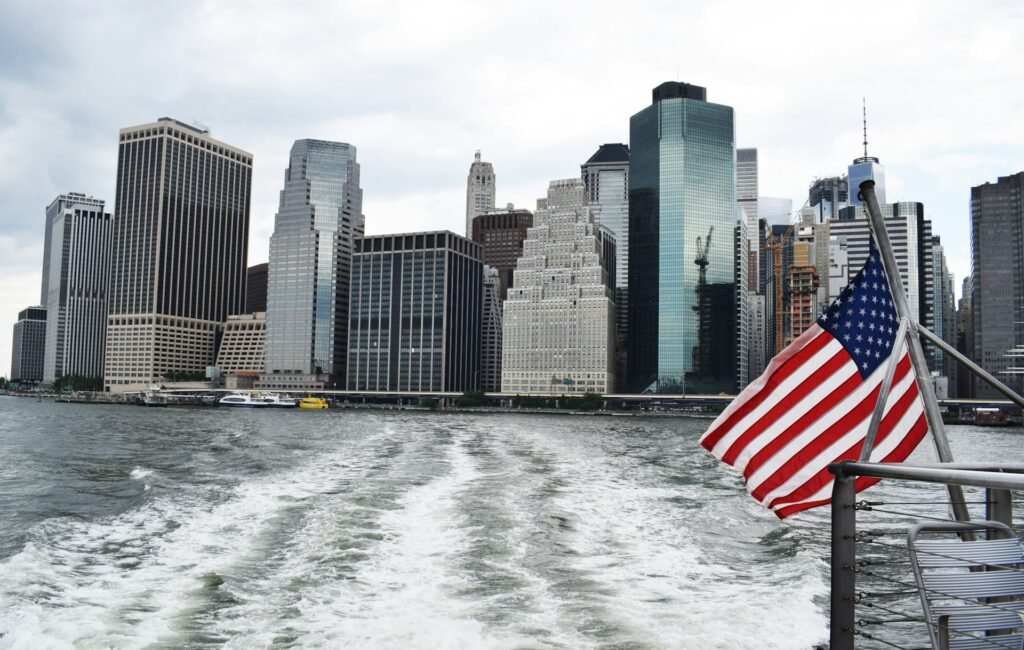This post may contain affiliate links which means we may receive a commission at no cost to you, if you make a purchase through a link. Please see our full disclosure for further information.
America’s story began long before it became the United States. It’s a tale of explorers, settlers, conflict, and growth. This is a summary of that history.
Early America
Before Europeans came, different Native American groups lived across the continent. They had different ways of life, shaped by the land around them.
- Mississippi Culture: These people built cities and large mounds for ceremonies and burials. They traded with others.
- Pueblos: In the Southwest, they built villages with many stories made of stone.
- Iroquois Confederacy: In the Northeast, five (later six) groups joined together. They created a government where people were chosen to represent them.
Some believe the Norse explorer Leif Ericson was the first European to reach North America, landing in what is now Newfoundland, Canada. However, his settlement didn’t last.
European Arrival
In the 1400s, Europeans started exploring the world. Christopher Columbus, sailing for Spain, reached the Americas in 1492. This led other Europeans to come to the “New World.”
Columbus’s voyages opened the door for others, but brought horrible consequences. He and his men treated the native people cruelly, killing many. Even more died from diseases brought by the Europeans, because they had no protection from them.
Colonization
Different European countries began claiming land in America.
- Spain took control of Florida, the Caribbean, and parts of South America.
- France focused on the fur trade and converting natives to Christianity, exploring down the Mississippi River.
- The Netherlands set up trading posts along the Hudson River, calling their colony New Netherland.
- England started colonies like Jamestown, Virginia, which grew rich from tobacco.
To work on their farms, colonists used indentured servants. These people were paid to come to America in exchange for working for a set time. Colonists later began using African slaves, who were forced to work without pay.
Beaver Wars
The Beaver Wars, a series of conflicts spanning much of the 17th century, were far more than skirmishes over fur—they were a collision of Indigenous power, European ambition, and the economic forces reshaping North America. At their core was the Iroquois Confederacy, a union of five nations (the Mohawk, Oneida, Onondaga, Cayuga, and Seneca) whose strategic vision and adaptability would make them pivotal players in the continent’s fur trade.
By the early 1600s, European demand for beaver pelts—used to make luxurious felt hats, a staple of 17th-century fashion—skyrocketed. The Dutch, establishing trading posts in present-day New York (like Fort Nassau), were among the first to strike deals with the Iroquois: in exchange for beaver furs, they supplied firearms, metal tools, and cloth. This trade was transformative. Firearms gave the Iroquois a decisive military edge over neighboring tribes, who relied on traditional weapons, while the furs fueled a lucrative pipeline to Europe.
But the Iroquois’ ambition stretched beyond trade. They sought to dominate the entire fur-rich region, from the Great Lakes to the St. Lawrence River. This put them directly at odds with rival tribes allied with the French, including the Huron, Algonquin, and Erie peoples. The French, eager to protect their own fur monopoly (centered on the St. Lawrence), armed these tribes, turning the conflict into a proxy war between European powers.
The wars were brutal and far-reaching. The Iroquois, using their new firepower and coordinated military tactics, launched raids to seize territory, disrupt rival trade routes, and weaken French-allied groups. By the 1640s, they decimated the Huron Confederacy, scattering its people and seizing control of their fur-rich lands around Lake Huron. Other tribes, like the Erie, were nearly wiped out, while survivors fled west or north, altering the Indigenous map of the Northeast.
Yet the conflict took a toll on the Iroquois too. Years of fighting drained resources, and by the late 1600s, both the French and British (who had replaced the Dutch in the region) began to push for peace, recognizing that endless war destabilized their colonial economies.
The turning point came with the Great Peace of 1701, signed in Montreal. Attended by over 1,300 delegates—including Iroquois leaders, French officials, British representatives, and 39 Indigenous nations—the treaty was a landmark. The Iroquois agreed to end hostilities with the French and their allies, while France and Britain recognized the Iroquois as a neutral power, free to trade with both. Crucially, the treaty also secured the Iroquois’ control over their traditional lands, cementing their role as a key broker in North American politics.
The Beaver Wars left a lasting legacy. They redrew Indigenous boundaries, weakened French influence in the interior, and established the Iroquois as a force to be reckoned with for decades. More than that, they revealed how Indigenous nations weren’t mere pawns in European games—they were shrewd actors, leveraging trade and diplomacy to safeguard their sovereignty in a world being remade by global commerce.
Conflict and Revolution
By the mid-1700s, North America buzzed with dynamic energy, as two European powers carved out their spheres of influence. France, for its part, controlled vast stretches of land—from the Great Lakes down to the Mississippi River—boasting rich territories teeming with resources.
In contrast, England’s 13 colonies along the Atlantic coast, though smaller in geographic scope, were thriving: their population was growing rapidly, fueled by immigration and a vibrant, community-driven spirit that made them a lively, bustling presence.
Yet, as these two powers expanded, tensions began to simmer—particularly over the fertile lands of the Ohio River Valley, a region both France and Britain coveted for its trade potential and strategic value. Notably, in 1754, these tensions boiled over into the French and Indian War, a pivotal conflict that would reshape the continent.
After years of hard-fought struggle, Britain emerged victorious, a triumph that brought transformative change: the treaty ending the war granted Britain control of much of France’s North American territory, expanding its colonial reach significantly. This victory was a landmark, solidifying Britain’s presence in the New World and redrawing the map of North America.
However, the cost of this triumph was steep. The war drained Britain’s coffers, leaving the empire grappling with heavy debt. Consequently, British leaders turned their attention to their North American colonies, seeing them as a source of revenue to ease the financial strain.
This shift would set the stage for new tensions, as the colonies began to face a wave of taxes—measures that, while intended to address Britain’s debts, would soon spark a deeper conversation about representation and self-governance.
Taxes and Protests
The colonists were angry about the new taxes. They felt they should not be taxed without having representatives in the British Parliament. They protested and boycotted British goods. Key events increased tensions:
- Boston Massacre (1770): British soldiers shot and killed five protesters.
- Boston Tea Party (1773): Colonists dumped tea into the harbor to protest tea taxes.
Revolution
In 1775, fighting broke out between the colonists and British soldiers. The colonists formed the Continental Army, led by George Washington.
On July 4, 1776, the colonies declared independence. Thomas Jefferson wrote the Declaration of Independence.
With help from France and Spain, the Continental Army eventually won the war. In 1783, the Treaty of Paris recognized the United States as an independent nation.
A New Nation
1787 marked a pivotal moment in history, as visionary leaders gathered to craft the U.S. Constitution—a document born not just of necessity, but of bold imagination. In a spirit of unity and foresight, they designed a government built on balance: power shared between states and a central authority, checks and balances to guard against overreach, and a framework flexible enough to grow with a young nation. It was a revolutionary leap, turning the idea of self-governance into a living, breathing system—one that trusted in the wisdom of the people to shape their own future.
Adding to this foundation, the Bill of Rights emerged as a heartfelt promise to citizens: the first 10 amendments enshrined freedoms that remain sacred to this day—freedom of speech, religion, and assembly; the right to a fair trial; protection from unjust search and seizure. These weren’t just words on paper, but a commitment to dignity, ensuring every voice mattered and no one was left unheard. They turned the Constitution from a structure into a sanctuary for liberty.
Then, in 1789, George Washington stepped into the role of the first president—not as a ruler, but as a servant. His leadership was defined by humility: he rejected titles of grandeur, served with a steady hand, and set precedents that would guide generations—from peaceful transitions of power to the idea that a president answers to the people. He wasn’t just a leader; he was a symbol of the nation’s best self: principled, collaborative, and dedicated to something larger than himself.
Together, these moments—an innovative Constitution, a Bill of Rights that celebrated freedom, and a president who led with grace—laid the groundwork for a nation rooted in hope. They proved that even in a time of uncertainty, unity, vision, and a commitment to justice could birth something extraordinary: a new nation, bound by ideals that would inspire freedom-seekers around the world for centuries to come.
Growth and Expansion
The U.S. continued to grow.
- President Thomas Jefferson bought the Louisiana Territory from France in 1803, doubling the country’s size.
- The U.S. fought the War of 1812 with Britain, which ended without major changes.
- President Andrew Jackson forced many Native Americans to move west, in what became known as the Trail of Tears.
- The U.S. annexed Texas and won the Mexican-American War (1846-1848), gaining more land in the West.
Civil War
As the country expanded, disagreements grew over slavery. The North was mostly against slavery, while the South depended on it for their economy.
When Abraham Lincoln, who was against the spread of slavery, was elected president in 1860, Southern states seceded from the Union, forming the Confederate States of America.
In 1861, the American Civil War began. The North had more industry and people, but the South had strong military leaders. After a bloody war, the North won in 1865. Slavery was abolished.
Shortly after the war ended, Lincoln was assassinated.
The 20th Century and Beyond
The U.S. continued to grow and change in the 20th century.
- The U.S. fought in World War I and World War II, becoming a major world power.
- The U.S. and the Soviet Union engaged in the Cold War, a long period of tension and competition.
- The U.S. made great advances in science and technology, including landing the first men on the moon.
- The Civil Rights Movement led to greater equality for African Americans.
Modern Challenges
The events of September 11, 2001, tested the United States in profound ways, yet in the face of tragedy, a powerful spirit of unity emerged. Communities rallied together, strangers supported one another, and a collective resolve to heal and strengthen took root—reminding the world of resilience that transcends adversity.
Today, that spirit endures, reflected in the nation’s standing as a global leader. Its economy thrives on innovation, driving breakthroughs in technology, medicine, and renewable energy that benefit people worldwide.
Conclusion
The history of America is complex and filled with many events. From the first people who arrived to the rise of a global superpower, the United States has had a long and interesting path. The story continues to unfold, with new challenges and opportunities shaping the nation’s future.
Want to learn more? Check out your local library!
North American Fairy Tales, Folktales and Fables
European Fairy Tale Route
US History
Uncover further inspiration in our blog.


















